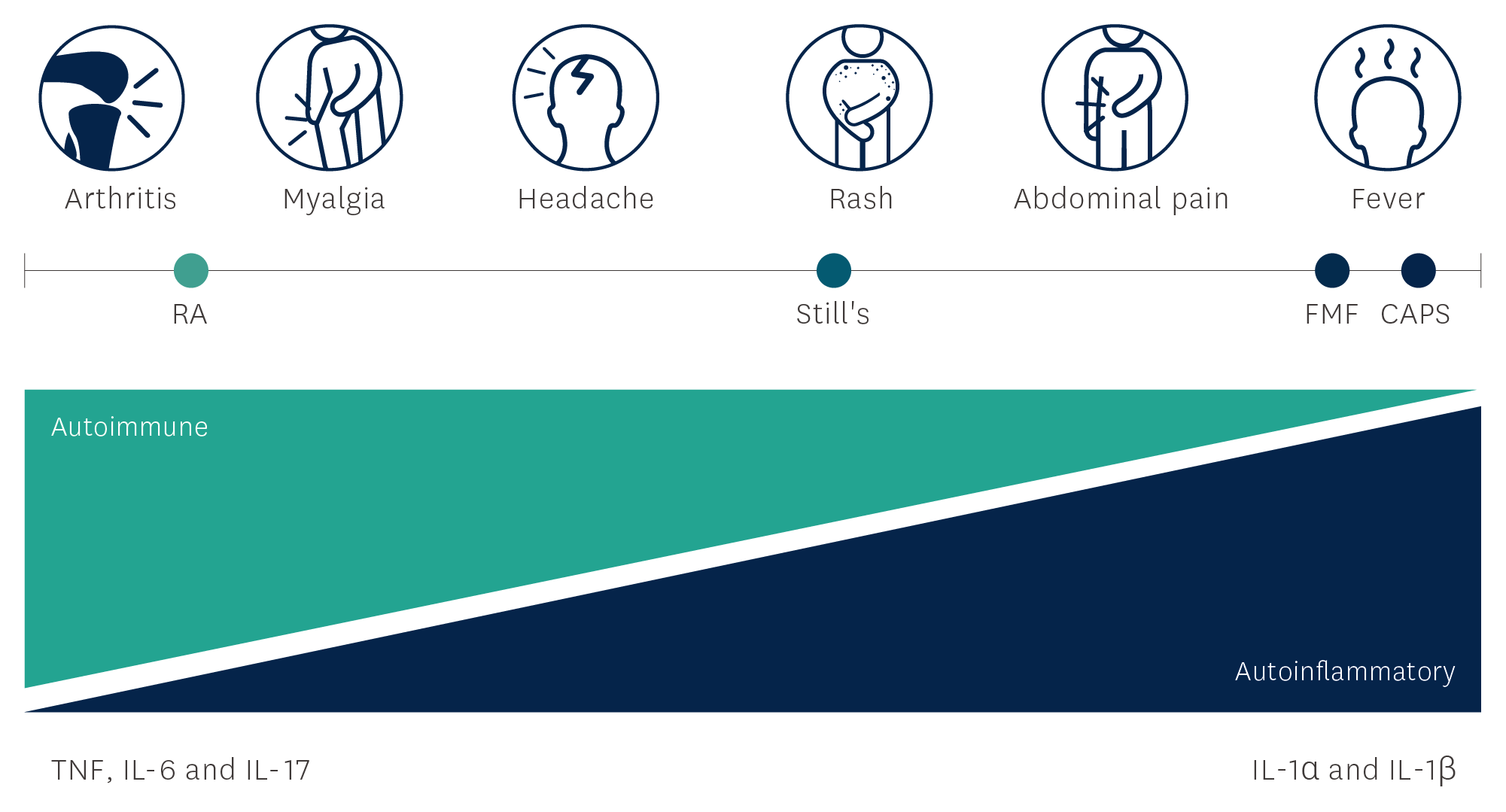IL-1 is a key mediator
IL-1 plays a crucial role in the immune system and inflammation, serving as a key mediator in both physiological and pathological processes.1 IL-1 exist in two different isoforms, IL-1α and IL-1β. IL-1α is often associated with intracellular functions and can be found in membrane-bound or cytosolic forms, playing a role in local inflammatory responses. In contrast, IL-1β is primarily produced by activated immune cells and is a potent inducer of systemic inflammation. IL-1α or IL-1β can induce further IL-1β transcription, in a self-induction loop mechanism known as autoinflammation.2,3
IL-1 is essential for coordinating immune defences against infections and injuries. It activates various immune cells, induces the production of other cytokines, and contributes to the inflammatory response necessary for pathogen clearance and tissue healing. However, dysregulation of IL-1 can lead to chronic inflammation with a broad variety of organ manifestations.4
Autoinflammatory diseases are a set of clinical disorders unified by recurrent febrile episodes accompanied by inflammatory cutaneous, mucosal, serosal and musculoskeletal manifestations. These diseases are characterised by a genetically driven dysregulated immune response that causes activation of the inflammasome and subsequent cytokine excess. Affected individuals often have a familial history of similar features and a monogenic defect has been identified for a number of these diseases.5
IL-1α and IL-1β are key cytokines in autoinflammatory diseases, such as Still’s disease, FMF and CAPS and in patients with RA with autoinflammatory traits.6
Symptoms of IL-1 dysregulation
IL-1 is implicated in a range of disorders characterised by dysregulated immune responses due to excessive production or impaired regulation of IL-1, leading to chronic inflammation and tissue damage. Conditions associated with IL-1 dysregulation include autoinflammatory diseases such as Still’s disease, cryopyrin-associated periodic syndromes (CAPS) and familial Mediterranean fever (FMF) that are characterised by recurrent fever episodes, systemic inflammation, and manifestations involving joints and other organs. Additionally, IL-1 is involved in autoimmune disorders like rheumatoid arthritis (RA), where it contributes to the chronic inflammation and joint destruction.3,4
CAPS, cryopyrin-associated periodic syndromes; FMF, familial Mediterranean fever; IL-1, interleukin-1; RA, rheumatoid arthritis; TNF, tumour necrosis factor.
References
- Cavalli G, Colafrancesco S, Emmi G, Imazio M, Lopalco G, Maggio MC, et al. Interleukin 1a: a comprehensive review on the role of IL-1a in the pathogenesis and treatment of autoimmune and inflammatory diseases. Autoimmun Rev. 2021;203:102763.
- Dinarello CA. Overview of the IL-1 family in innate inflammation and acquired immunity. Immunol Rev. 2018 Jan 16;2811:8-27.
- Dinarello CA, Simon A, van der Meer JWM. Treating inflammation by blocking interleukin- 1 in a broad spectrum of diseases. Nat Rev Drug Discov. 2012;118:633-52.
- Broderick L, Hoffman HM. IL-1 and autoinflammatory disease: biology, pathogenesis and therapeutic targeting. Nat Rev Rheumatol. 2022;188:448-63.
- Wekell P, et al. Front Immunol. 2017;8:497.4.
- Kineret Summary of Product Characteristics. https://www.medicines.org.uk/emc/product/559/smpc (Accessed April 2025).
Adverse events should be reported. Reporting forms and information can be found at www.mhra.gov.uk/yellowcard or search MHRA Yellow Card in the Google Play or Apple App Store (for United Kingdom) and www.hpra.ie (for Republic of Ireland). Adverse events should also be reported to Swedish Orphan Biovitrum Ltd at [email protected] or Telephone +44 (0) 800 111 4754




